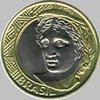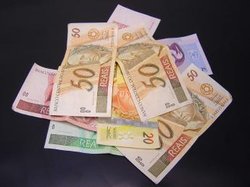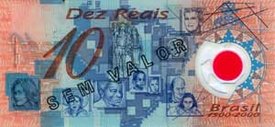Real (currency)
|
|
The real (plural reais) is the present monetary unit (currency) of Brazil.
| Contents |
History
Past
The "real" was the currency used by the first Portuguese settlers to arrive in the then New World, but the first official money to circulate bearing the name "real" was actually printed in 1654 by the Dutch, during their occupation of part of the Brazilian Northeast. The first time the real became Brazil's official currency was in 1690, and it would remain as such until 1942, when it was replaced with the cruzeiro.
Millesimal Base
During that period, however, the real did not have the centesimal base that it has today. Its plural spelled réis and it was counted in "thousand reais" (mil-réis). Accordingly, 1000 mil-réis formed one conto de réis, or simply conto (e.g.: an amount of $1,020,800.40 would be expressed as follows: Rs 1.020:800$400).
Present
The Real was implemented on 1 July 1994, during the presidency of Itamar Franco, when Fernando Henrique Cardoso was the Minister of Finances. The new currency's success paved the way to Mr. Cardoso's victory in the presidential election held in that same year.
It replaced the previous currency, the cruzeiro. The real was preceded by a conversion unit called URV (Portuguese: Unidade Real de Valor; English: "Real" Value Unit), which was meant to express values in the yet-to-be-implemented currency as opposed to those in the previous currency. On 1 July, 1994, 1 URV = Cr$2,750.00 (cruzeiro value); 1 URV = 1 real.
One of the main goals of the new currency was to end a period of high inflation and stabilize the currency exchange rate. 100 cents (centavos) = 1 real. Its symbol is R$ and its abbreviation (ISO 4217) is BRL.
Bills
|
Plastic bill
In April 2000, in celebration of the 500th anniversary of the Portuguese arrival on Brazilian shores, the Brazilian Central Bank released a plastic 10 reais bill that circulates along with the other bills above. It is made primarily of polymer.
The Brazilian Mint printed 250 million units, which at the time accounted for about half of the 10 reais bills in circulation.
|
Illustrations
The plastic bill contains a more complex pattern, as follows:
Front:
- Image of Pedro Álvares Cabral, Portuguese sea captain;
- A representation of the map "Terra Brasilis", one of the earliest drawings of the land;
- A passage from Pero Vaz de Caminha's letter to King Manuel I of Portugal, the first known description of Brazil;
- A 16th century Portuguese Rose of Winds;
- To the right of the map, five ships from Cabral's expedition appear;
- In the background, decorative elements from Portuguese tiles can be seen;
- The white area around the red dot is actually transparent (the red dot is also transparent, but due to the color, less so);
- Finally, also in the background, the Cross from the Order of Christ, which was present in all Portuguese ships of the time, appears.
Back: A styled version of a map of Brazil with photographs depicting the ethnic variety of the Brazilian people (white, black, indian and mestizo).
See Also: Polymer banknote
Coins
For each denomination, two types of coin exist in Brazil. The original one, released in 1994, had stainless steel as its primary material. Those coins are called First Family. Later, the government decided to release a second set of coins, with different colors and sizes, to facilitate the use by the general public and hinder counterfeiting. Those are the Second Family, released in 1998. Both are equally valid, but the government has plans to eventually remove the First Family from circulation and keep only the second set of coins. On December 23, 2003, the First Family's one real coin was removed from circulation and is no longer valid. The process to completely replace it with the Second Family's coin is expected to be long and slow, and the old coin is still exchangeable for the new one at designated places (commercial banks, Central Bank agencies, etc.).
All pictures in boards are in scale.
First family
Second family
<tr><td>
| Value | Front | Back Side | Engravings |
|---|---|---|---|
| 0,01 | Missing image 1centavoII.jpg One Cent |
 |
Front: The South Cross (star constellation) in right upper side. Back: Depicts Pedro Álvares Cabral, Portuguese sea captain. 1500s Portuguese ship in the background. |
| 0,05 |  |
 |
Front: The South Cross (star constellation) in right upper side. Back: Depicts Joaquim José da Silva Xavier (a.k.a. Tiradentes), martyr of early independence movement. In the background, a triangle, symbol of the movement, and a dove, symbol of peace and freedom. |
| 0,10 |  |
 |
Front: The South Cross (star constellation) in right upper side. Back: Depicts Emperor Peter I, Brazil's first monarch. In the background, the Emperor on a horse: scene allusive to the proclamation of independence. |
| 0,25 |  |
 |
Front: The South Cross (star constellation) in right upper side. Back: Depicts Field Marshal Manuel Deodoro da Fonseca, Brazil's first Republican president. The Republic's coat of arms is in the background. |
| 0,50 |  |
 |
Front: The South Cross (star constellation) in right upper side. Back: Depicts José Maria da Silva Paranhos Júnior (a.k.a. Baron of Rio Branco), the country's most distinguished Minister of Foreign Affairs. In the background, image of the country with ripples expanding outwards, representing the expansion of Brazil's foreign policy and the solidification of the national borders. |
| 1 | Missing image 1realII_2.jpg One Real |
 |
Front: The South Cross (star constellation) in right upper side. Back: Outer ring depicts sample of marajoara art pattern. In the inner ring, the sphinx, symbol of the Republic. |
See also
Current BRL exchange rates
AUD (http://finance.yahoo.com/currency/convert?amt=1&from=AUD&to=BRL&submit=Convert) | CAD (http://finance.yahoo.com/currency/convert?amt=1&from=CAD&to=BRL&submit=Convert) | EUR (http://finance.yahoo.com/currency/convert?amt=1&from=EUR&to=BRL&submit=Convert) | GBP (http://finance.yahoo.com/currency/convert?amt=1&from=GBP&to=BRL&submit=Convert) | INR (http://finance.yahoo.com/currency/convert?amt=1&from=INR&to=BRL&submit=Convert) | NZD (http://finance.yahoo.com/currency/convert?amt=1&from=NZD&to=BRL&submit=Convert) | USD (http://finance.yahoo.com/currency/convert?amt=1&from=USD&to=BRL&submit=Convert)
External links
- Official website of the Brazilian Central Bank (English version) (http://www.bc.gov.br/?english)
- Official website of the Brazilian Central Bank (Portuguese version) (http://www.bc.gov.br): More complete.
- Official website of the Brazilian Mint (http://www.casadamoeda.com.br/) (in Portuguese).
Template:AmericanCurrenciesde:Brasilianischer Real fr:Real ja:レアル no:Real pt:Real (moeda) zh:黑奧

















